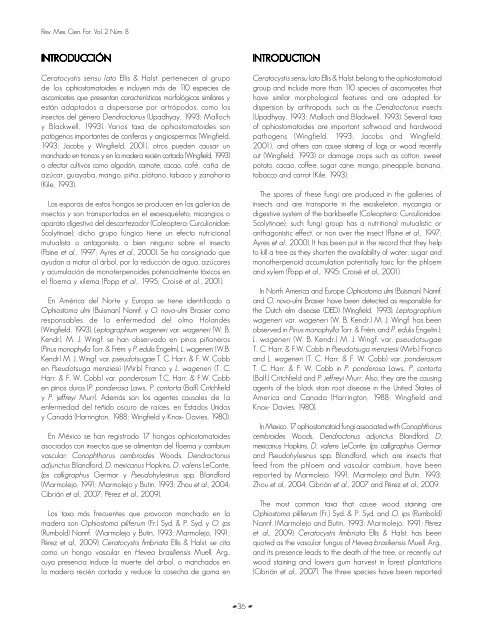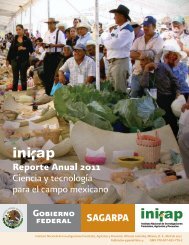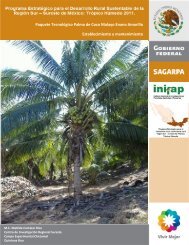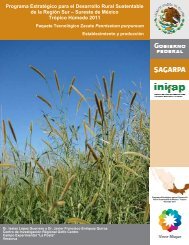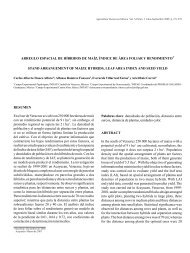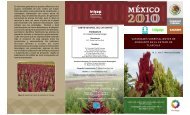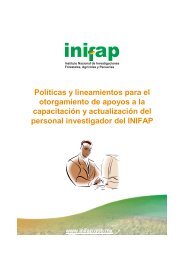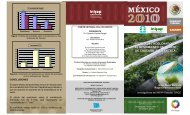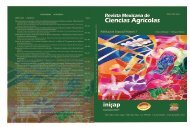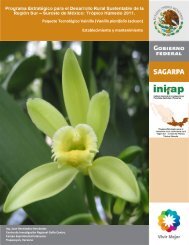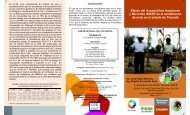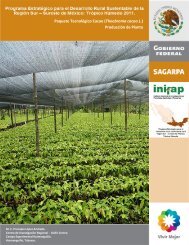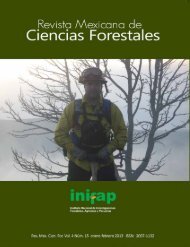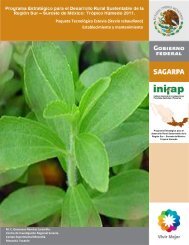Vol. 2 Núm. 8 - Instituto Nacional de Investigaciones Forestales ...
Vol. 2 Núm. 8 - Instituto Nacional de Investigaciones Forestales ...
Vol. 2 Núm. 8 - Instituto Nacional de Investigaciones Forestales ...
- No tags were found...
You also want an ePaper? Increase the reach of your titles
YUMPU automatically turns print PDFs into web optimized ePapers that Google loves.
Rev. Mex. Cien. For. <strong>Vol</strong>. 2 Núm. 8INTRODUCCIÓNCeratocystis sensu lato Ellis & Halst. pertenecen al grupo<strong>de</strong> los ophiostomatoi<strong>de</strong>s e incluyen más <strong>de</strong> 110 especies <strong>de</strong>ascomicetes que presentan características morfológicas similares yestán adaptados a dispersarse por artrópodos, como losinsectos <strong>de</strong>l género Dendroctonus (Upadhyay, 1993; Mallochy Blackwell, 1993). Varios taxa <strong>de</strong> ophiostomatoi<strong>de</strong>s sonpatógenos importantes <strong>de</strong> coníferas y angiospermas (Wingfield,1993; Jacobs y Wingfield, 2001), otros pue<strong>de</strong>n causar unmanchado en troncos y en la ma<strong>de</strong>ra recién cortada (Wingfield, 1993)o afectar cultivos como algodón, camote, cacao, café, caña <strong>de</strong>azúcar, guayaba, mango, piña, plátano, tabaco y zanahoria(Kile, 1993).Las esporas <strong>de</strong> estos hongos se producen en las galerías <strong>de</strong>insectos y son transportadas en el exoesqueleto, micangios oaparato digestivo <strong>de</strong>l <strong>de</strong>scortezador (Coleoptera: Curculionidae:Scolytinae); dicho grupo fúngico tiene un efecto nutricionalmutualista o antagonista, o bien ninguno sobre el insecto(Paine et al., 1997; Ayres et al., 2000). Se ha consignado queayudan a matar al árbol, por la reducción <strong>de</strong> agua, azúcaresy acumulación <strong>de</strong> monoterpenoi<strong>de</strong>s potencialmente tóxicos enel floema y xilema (Popp et al., 1995; Croisé et al., 2001).En América <strong>de</strong>l Norte y Europa se tiene i<strong>de</strong>ntificado aOphiostoma ulmi (Buisman) Nannf. y O. novo-ulmi Brasier comoresponsables <strong>de</strong> la enfermedad <strong>de</strong>l olmo Holandés(Wingfield, 1993). Leptographium wageneri var. wageneri (W. B.Kendr). M. J. Wingf. se han observado en pinos piñoneros(Pinus monophylla Torr. & Frém. y P. edulis Engelm), L. wageneri (W.B.Kendr) M. J. Wingf. var. pseudotsugae T. C. Harr. & F. W. Cobben Pseudotsuga menziesii (Mirb) Franco y L. wageneri (T. C.Harr. & F. W. Cobb) var. pon<strong>de</strong>rosum T.C. Harr. & F.W. Cobben pinos duros (P. pon<strong>de</strong>rosa Laws., P. contorta (Balf) Critchfieldy P. jeffreyi Murr). A<strong>de</strong>más son los agentes causales <strong>de</strong> laenfermedad <strong>de</strong>l teñido oscuro <strong>de</strong> raíces, en Estados Unidosy Canadá (Harrington, 1988; Wingfield y Knox- Davies, 1980).En México se han registrado 17 hongos ophiostomatoi<strong>de</strong>sasociados con insectos que se alimentan <strong>de</strong>l floema y cambiumvascular: Conophthorus cembroi<strong>de</strong>s Woods, Dendroctonusadjunctus Blandford, D. mexicanus Hopkins, D. valens LeConte,Ips calligraphus Germar y Pseudohylesinus spp. Blandford(Marmolejo, 1991; Marmolejo y Butin, 1993; Zhou et al., 2004;Cibrián et al., 2007; Pérez et al., 2009).Los taxa más frecuentes que provocan manchado en lama<strong>de</strong>ra son Ophiostoma piliferum (Fr.) Syd. & P. Syd. y O. ips(Rumbold) Nannf. (Marmolejo y Butin, 1993; Marmolejo, 1991;Pérez et al., 2009). Ceratocystis fimbriata Ellis & Halst. se citacomo un hongo vascular en Hevea brasiliensis Muell. Arg.,cuya presencia induce la muerte <strong>de</strong>l árbol, o manchados enla ma<strong>de</strong>ra recién cortada y reduce la cosecha <strong>de</strong> goma enINTRODUCTIONCeratocystis sensu lato Ellis & Halst. belong to the ophiostomatoidgroup and inclu<strong>de</strong> more than 110 species of ascomycetes thathave similar morphological features and are adapted fordispersion by arthropods, such as the Dendroctonus insects(Upadhyay, 1993; Malloch and Blackwell, 1993). Several taxaof ophiostomatoi<strong>de</strong>s are important softwood and hardwoodpathogens (Wingfield, 1993; Jacobs and Wingfield,2001), and others can cause staining of logs or wood recentlycut (Wingfield, 1993) or damage crops such as cotton, sweetpotato, cacao, coffee, sugar cane, mango, pineapple, banana,tobacco and carrot (Kile, 1993).The spores of these fungi are produced in the galleries ofinsects and are transporte in the exoskeleton, mycangia ordigestive system of the barkbeetle (Coleoptera: Curculionidae:Scolytinae); such fungi group has a nutritional mutualistic oranthagonistic effect, or non over the insect (Paine et al., 1997;Ayres et al., 2000). It has been put in the record that they helpto kill a tree as they shorten the availability of water, sugar andmonotherpenoid accumulation potentially toxic for the phloemand xylem (Popp et al., 1995; Croisé et al., 2001).In North America and Europe Ophiostoma ulmi (Buisman) Nannf.and O. novo-ulmi Brasier have been <strong>de</strong>tected as responsible forthe Dutch elm disease (DED) (Wingfield, 1993). Leptographiumwageneri var. wageneri (W. B. Kendr.) M. J. Wingf. has beenobserved in Pinus monophylla Torr. & Frém. and P. edulis Engelm.);L. wageneri (W. B. Kendr.) M. J. Wingf. var. pseudotsugaeT. C. Harr. & F.W. Cobb in Pseudotsuga menziesii (Mirb.) Francoand L. wageneri (T. C. Harr. & F. W. Cobb) var. pon<strong>de</strong>rosumT. C. Harr. & F. W. Cobb in P. pon<strong>de</strong>rosa Laws., P. contorta(Balf.) Critchfield and P. jeffreyi Murr. Also, they are the causingagents of the black stain root disease in the United States ofAmerica and Canada (Harrington, 1988; Wingfield andKnox- Davies, 1980).In Mexico, 17 ophiostomatoid fungi associated with Conophthoruscembroi<strong>de</strong>s Woods, Dendroctonus adjunctus Blandford, D.mexicanus Hopkins, D. valens LeConte, Ips calligraphus Germarand Pseudohylesinus spp. Blandford, which are insects thatfeed from the phloem and vascular cambium, have beenreported by Marmolejo, 1991; Marmolejo and Butin, 1993;Zhou et al., 2004; Cibrián et al., 2007 and Pérez et al., 2009.The most common taxa that cause wood staining areOphiostoma piliferum (Fr.) Syd. & P. Syd. and O. ips (Rumbold)Nannf. (Marmolejo and Butin, 1993; Marmolejo, 1991; Pérezet al., 2009). Ceratocystis fimbriata Ellis & Halst. has beenquoted as the vascular fungus of Hevea brasiliensis Muell. Arg.,and its presence leads to the <strong>de</strong>ath of the tree, or recently cutwood staining and lowers gum harvest in forest plantations(Cibrián et al., 2007). The three species have been reported36


